Zoom
Trash

Schwammy Says... Aspect-Oriented Programming - A Microsoft Guide. Matthew Deiters ThoughtWorks September 2005 Applies to: Microsoft Visual Studio Microsoft Visual Basic Summary: A practical look at aspect-oriented programming demonstrating how to dynamically extend behavior in Web-service client applications. (11 printed pages) Click here to download the code sample for this article. Contents Introduction Aspect Oriented Programming (AOP) has been around for a long time but recently has begun to get more attention from the Microsoft .NET development community. What Is an Aspect? When thinking of an object and its relationship to other objects we often think in terms of inheritance.
In software terms, aspect-oriented programming allows us the ability to apply aspects that alter behavior to classes or objects independent of any inheritance hierarchy. Joinpoint—Well defined points in code that can be identified. To better understand these terms, think of a joinpoint as a defined point in program flow. AOP: The Good and the Bad Beyond Trace.WriteLine.
.NET Aspect-oriented Approaches (Eric Bodden, Ph.D.) Introduction This is an incomplete list of frameworks and tools supporting aspect-oriented programming under the .NET framework.

It is separated by technology. The comments stated below are sometimes just copied form the author’s website, to those are not necessarily objective evaluations! If you find anything is missing or this site could be improved in any other way, please sent your comment to Eric Bodden. You can find our related (German) article here: Torsten Weber und Eric Bodden – bit-Fabrik: Zweigstelle, Hauptstelle, Dienstleister: Aspektorientierte Programmierung mit .NET.
Proxy-based approaches. AOP in C# - Aspect Oriented Programming using .NET - C. Aspect Oriented Programming or AOP is an interesting concept that can be applied to many of the programming problems we solve everyday.

In our Visual Studio team system code we have a lot of web-services and remoting code that essentially does the following public void MyMethod(int parameter){ Trace.EnteredMethod("MyMethod", parameter); SecurityCheck(); // Bunch of processing Trace.ExitMethod("MyMethod");} This is not just peculiar to our domain but is seen across different domains. In OO programming classes and methods are designed for performing specific operations and common/duplicate functionality are factored out into common classes. However, there are cross-cutting concerns that span accross all classes and methods, like logging and security checks. Aspect F - Fluent Aspect Framework. AspectF offers you separation of concern, without the bells and whistles.
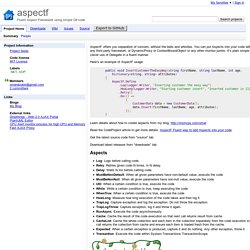
You can put Aspects into your code without using any third party framework, or DynamicProxy or ContextBoundObject or any other mumbo jumbo. It's plain simple C# code, clever use of Delegate in a fluent manner. Here's an example of AspectF usage: Introduction to AOP With Castle - Castle Project. If you look at canonical terms of AOP you can recognize standard ones such as Aspect, JointPoint, PointCut , but if you look at castle infrastructure you could not find any of these.

This does not mean that castle does not support AOP, but is a clue that Castle handles AOP with different point of view respect to other frameworks. Now I want to be able to intercept every call and log it; the solution in castle is to create an interceptor like this. As you can see, the IInterceptor interface has only a single method, called Intercept, that gets called whenever a method or property of the wrapped interface is called. Now we need only to instruct Windsor to intercept an object with this interceptor, here is the solution with standard XML config files. You got this output. Fluent interface has the Interceptors() method that you can use to list a series of reference to registered interceptors, and you can verify that the output of this snippet is exactly the same of the previous example. Aspect Oriented Programming in C#.NET: Part I. Introduction.
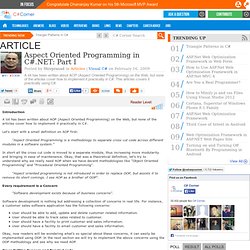
Aspect Oriented Programming in C#.NET: Part II. Attributed Programming OK guys, I have never written any article spanning in parts.
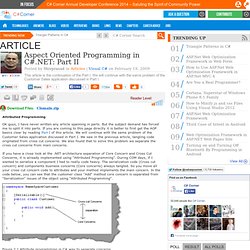
But the subject demand has forced me to split it into parts. If you are coming to this page directly it is better to first get the AOP basics clear by reading Part I of this article. We will continue with the same problem of the Customer Sales application discussed in Part I. We saw in the previous article, tangling code originated from cross cut concerns. If you have a close look at the .NET architecture separation of Core Concern and Cross Cut Concerns, it is already implemented using "Attributed Programming". AvalonFramework - Excalibur Wiki. Avalon-Framework is a small but vital jar file distributed by the Avalon project, and some associated documentation.
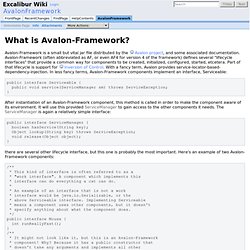
Avalon-Framework (often abbreviated as AF, or even AF4 for version 4 of the framework) defines several "lifecycle interfaces" that provide a common way for components to be created, initialized, configured, started, etcetera. I want my AOP!, Part 1. A concern is a particular goal, concept, or area of interest.
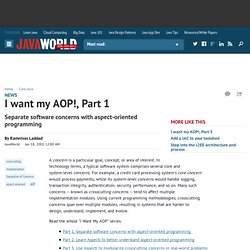
In technology terms, a typical software system comprises several core and system-level concerns. For example, a credit card processing system's core concern would process payments, while its system-level concerns would handle logging, transaction integrity, authentication, security, performance, and so on. Many such concerns -- known as crosscutting concerns -- tend to affect multiple implementation modules. Using current programming methodologies, crosscutting concerns span over multiple modules, resulting in systems that are harder to design, understand, implement, and evolve.
Read the whole "I Want My AOP" series: I want my AOP!, Part 2. I want my AOP!, Part 3. A spect-oriented programming (AOP) -- a new programming paradigm -- allows modular implementation of crosscutting concerns.
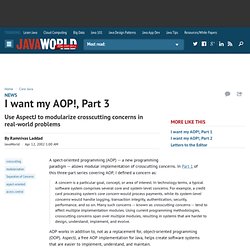
In Part 1 of this three-part series covering AOP, I defined a concern as: A concern is a particular goal, concept, or area of interest. Aop.